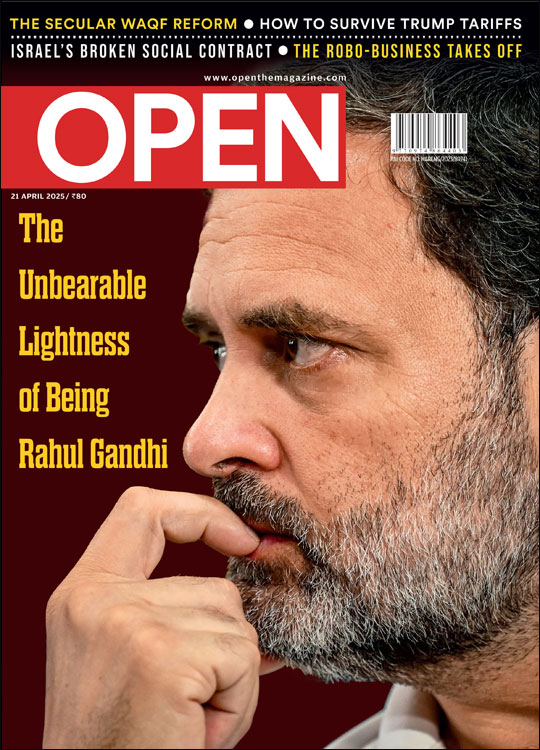FARMER ENTRAPPED
Incentives to help farmers stay put in agriculture are a short cut, and the Centre should focus on shifting them away to lucrative avenues
/wp-content/uploads/2016/01/18506.farmerentrapped1.jpg)
The year: 2009. It was several weeks after farmer suicides rocked Vidarbha in Maharashtra that the then Prime Minister Manmohan Singh finally decided to visit the drought-ravaged region. A joint secretary handling agriculture in the PMO turned irritable when asked why the Government had been so slow to wake up to the gravity of hundreds of poverty-stricken farmers taking their own lives. “Who asked them to stick with farming?” the bureaucrat asked. Agriculture Minister Sharad Pawar was asked if he had plans to stem the dangerously southward tilt of the primary sector, especially if the rains were not good enough. “How do I know? I’m not an astrologer,” replied the veteran politician. That sentiment, unfortunately enough, was echoed by Singh himself later. All he did, apparently under instructions of the Gandhi family, was announce incentive after incentive for farmers to stay put, with no effort to shift them away from a sector whose share in India’s output is dropping rapidly. Indeed, the Agricultural Debt Waiver and Debt Relief schemes of 2008, launched by the Singh Government, were telling commentaries on the state of farming in the country. These moves echoed practices followed by the British to redress farm sector grievances, the difference being that during the Raj, the loan waivers extended even to credit taken from private moneylenders at exorbitant interest rates since there were no public sector banks at the time.
The year: 2015. High input prices, unseasonal rains and hailstorms at the start of the rabi sales season (and forecasts of a below-normal monsoon in the offing) have once again brought farmer suicides and prospects of a poor crop to the fore. And the main opposition Congress is peddling that old balm for all ailments of the farm and allied sectors: loan waivers. Multiple forecasts suggest that the agri-commodities market is likely to stay highly volatile throughout the year, exposing both commercial and food crop farmers to high risks and uncertainties in the near-complete absence of any basic input and output infrastructure and institutional support in India’s geographically vast agriculture sector.
Agriculture and its allied sectors like fisheries and forestry have been on the decline for years now, with erstwhile governments doing precious little to arrest the trend. By the early 2000s, the contribution of the sector to India’s economy had fallen to slightly over 20 per cent, down from as high as 50 per cent in the years after Independence. Today, it accounts for merely 13.7 per cent of GDP. Yet, it continues to support nearly half the nation’s total workforce. Demographically, it continues to be the broadest economic sector, and it plays a significant role in the socio-economic life of India. As the writer P Sainath had said in 2008, ‘The [farm loan] waiver scheme does bring great relief to large numbers of farmers. But it is no solution to even the immediate crisis, let alone long-term agrarian problems. Not coming up with a far-sighted solution to boost farm productivity (output per acre) and stabilise incomes means that farmers will be back in debt in two years. Their incomes have been for long much lower on average than those in other sectors. And they fall further behind each year. Worse, fresh credit comes at a stiffer price to the farmer… there is no price stabilisation fund to shield farmers from the volatility of global prices.’ Arguing for a five-year repayment cycle to weather consecutive crop seasons of farm hardship, he also called for a drastic change in the fundamentally skewed crop insurance rules.
The problems hounding the sector have got compounded over the years. Indian farming is faced with an alarming fragmentation of land, low water tables, high cost of inputs (ranging from fertilizers and pesticides to water and electricity), erratic labour availability, transportation handicaps, high cost of borrowings, lack of standardised warehouse facilities and cold storage infrastructure to meet countrywide demand, lack of last-mile financial inclusivity, huge volatility in prices, poor access to market prices for commodities, highly restricted and unjust crop insurance terms, and to top it all, the political unwillingness of the ruling establishment down the decades to take a beyond-the- monsoons approach.
Many or all of these problems are rendered more complex on account of severe lack of information across the board, most glaringly on appropriate crop choices in regions such as Punjab, India’s key state for official foodgrain procurement, where a fast-falling water table has been worsened by the cultivation of water-guzzlers such as sugarcane (earlier) and rice. Changes, such as the increasing presence of the private sector fertiliser and agri business and even telecom companies, have certainly helped, but the gap of unmet needs still yawns inexorably. There is consensus among many of the sector’s observers and analysts that the State’s machinery and infrastructure in every area of possible intervention in the farm sector has been cornered mainly by better-off farmers year after year, leaving a large number of small and medium farmers bereft of urgent institutional support.
Again, according to studies, including those based on NSSO figures, close to 40 per cent of the loans taken by farmers ended up being used for non-agricultural purposes, worsening repayment problems acutely. Yet, there has been no serious attempt over the decades to make easy consumption loans for farmers—accessed by millions of them from non-institutional lenders anyway—as distinct from ‘farm loans’, a reality. Analyst N Srinivasan contends that agricultural debt waiver and relief schemes are a direct result of poor farming profitability. “But the waiver treats default as a cause and looks at remedying the situation by extinguishing default. This would at best be a temporary solution as a long as the basic causes of low profitability in agriculture are not addressed… credit, as the key vehicle for routing relief to farmers, is a flawed choice. There is no evidence to suggest that increasing credit flow to agriculture has resulted in increased production or productivity or profitability.” While credit flow to agriculture has been increasing, the share of agriculture in the country’s GDP has been consistently declining, he points out.
Other sectoral analysts agree that credit can, at best, provide liquidity and smoothen consumption and the production needs of farmers. Recently, Professor MS Swaminathan emphasised that the loan waiver scheme, recommended to the Government as far back as 2005, should be viewed as ‘the beginning of the process in which the goal should be getting over 30 million small and marginal farmers back into the credit system and back to productive farming’. Stressing that loan waivers alone could not be viewed as an elixir for the sector, he pointed out that 60 per cent of all defaulters were from dry, rain-fed areas and the rest from irrigated areas where farmers also had to rely on rains in view of declining groundwater levels.
Says Chukki Nanjundaswamy, who works with women farmers in rural Karnataka: “If proper infrastructure for agriculture is in place, we can hope to see more private companies coming up in agriculture, which would be beneficial for farmers. This would incorporate the farmers into the mainstream and it might put an end to the incessant subsidies in agriculture.” Agrees Professor Swaminathan: “We have a system of agri-credit that is not structurally sound. We do not have effective crop or weather insurance systems. When the rain falls, farmers still have to pay back their loans. As a result, the farmer goes to a moneylender to pay off existing loans so that he can be eligible again for institutional credit.”
The solution to the larger problem, contends a senior bureaucrat in the Union Agriculture Ministry, will first require policymakers to step back and take a fresh look at the fundamental changes needed in the sector. “What should not be done is coining and incentivising national policies— such as the MGNREGA—based on entitlements that will encourage their staying put in rural areas as disguised labour in the farm sector. The rural job guarantee scheme reversed the policies of decades that had been tailored to facilitate migration from villages to cities away from agriculture.” There is also an urgent need to change the way the Government views food security in the liberalised world where agri commodities are increasingly vulnerable to global volatility in prices, he argues.
In this archaic framework of food security, even relatively ‘pampered’ rice and wheat farmers find they must suffer—ironically—in bumper- crop seasons because surplus production depresses prices for them, done mostly in the name of keeping food inflation low. Informed practices of agriculture, crucial to the sector, have repeatedly fallen by the wayside; the statist mechanism has been structurally geared to disadvantage the producer in times of plenty in the absence of a truly guaranteed income. In the case of select commercial crops such as sugar and cotton, which are directly linked to global commodity markets, domestic prices reflect fluctuations across the world, the bureaucrat explains. He argues in favour of restructuring India’s farm sector policy at a fundamental level, focusing instead on delivering a manufacturing boost in order to wean excess farm labour off unprofitable farms and into other more productive sectors.
This growth pattern, aimed at drawing people away from the primary into the secondary sector and endorsed by the Modi Government, takes its inspiration from the perspectives of various experts. The farm sector in India had become unviable as far back as the turn of the century, and it was primarily flawed state policies and political humbug—including the MGNREGA— that kept farmers at subsistence levels rather than providing them opportunities to diversify and move out of unsustainable farming activities. “Both the nature and economics of farming have changed drastically in recent decades without the State acknowledging this. What we need is a new economic model for farm sector growth, linked with other sectors. What we have to coin is a structurally receptive response to emerging and hard realities,” in the words of the senior bureaucrat.
Analyst Kannan Kasturi points out that the grave existential crisis of agriculture is not unique to India. The world over, there was a period in history when a greater part of the workforce engaged in agriculture under conditions of low productivity in comparison with industry. In countries that achieved economic success, industrialisation progressed as labour moved off the farms. Migration away from the farm sector opened up avenues for less fragmentation and higher productivity in the farm sector itself, eventually closing the gap between the primary sector and industry. The rapid transformation of these economies, from a stage in which agriculture accounted for the lion’s share of employment and GDP to one where industry took its place, has been termed a ‘structural transformation or shift’.
Kasturi points out that ‘structural shifts’ from agriculture to industry happened not only in the West, but also in Asia— in Japan, South Korea and Taiwan. He notes, “In most countries after the shift, the share of manufacturing in employment increased to over 30 per cent. In the industrial powerhouses Britain and Germany, this share reached 45 per cent and 40 per cent, respectively, at its height. Since then, there has been a decline in the share of industrial employment in these countries. But it must be noted that the second structural shift in employment, this time from industry to services happened only after industry had attained a share of about 50 per cent of GDP.”
India, however, is way behind in industrial development, and in the manufacturing sector in particular. A private sector- led boom in the services sector has meant that the country’s economy has almost skipped the industrial stage of expansion that most rich countries have had. Closer home, China too, it appears, is on its way to a structural transformation with manufacturing accounting for about 33 per cent of its GDP (industry overall, 46 per cent). Claims have been made lately that a structural shift in employment out of agriculture, though greatly delayed, may finally be in progress in India too. The claim, says Kasturi, is based on the sharp 10 per cent drop in the share of agriculture in total employment between 2004-05 and 2011-12, and the fact that the absolute numbers employed in agriculture have declined for the first time since 2004.
The declining participation of the labour force in agriculture could have been treated as a natural, even inevitable, phase in the country’s transition towards industrialisation, Kasturi argues. Agri expert Devinder Sharma says that going by CACP figures, the net return for wheat on an all-India basis is Rs 14,260 per hectare. For mustard, the figure is Rs 14,960, and for gram, Rs 7,479. In Uttar Pradesh, the earnings per month for a farmer cultivating both wheat and rice works out to Rs 15,669 or a mere Rs 1,306 per month through the year. “With such a low return from wheat cultivation, there would always be the possibility of a UP farmer being distressed enough to commit suicide,” Sharma says. To generate dignified employment for millions of workers trapped in agriculture and poverty, India needs to break away from the status quo.
It is time to take a leap of faith.
About The Author
CURRENT ISSUE
The Unbearable Lightness of Being Rahul Gandhi
MOst Popular
3

/wp-content/uploads/2025/04/Cover-Congress.jpg)












More Columns
Ukraine silently encroaches on ‘friendly’ Moldova Ullekh NP
NFRA chief Ajay Pandey joins AIIB Rajeev Deshpande
The Revenge of Roughage V Shoba